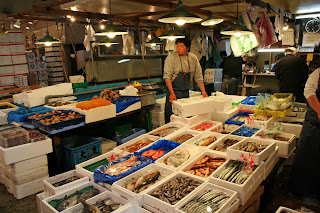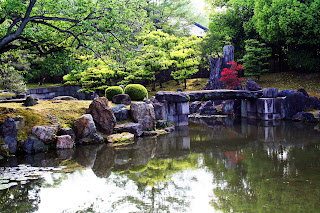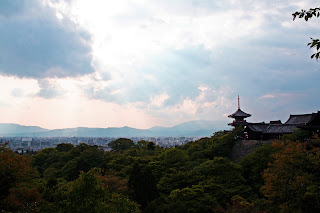


One of my favorite parts of my visit to Ethiopia last year was wandering through a local market in the town of Lalibela. Sightseeing is great, but I never feel like I see how the local people really live when I’m just visiting touristy places. Before coming to Japan I read about Tsukiji Fish Market, a wholesale market with docks on Tokyo Bay where all the seafood eaten in the city is bought and sold. Tsukiji was a must-visit site in Tokyo for me, and I crawled out of bed at 5:00 AM to be there when the morning catch would be sold.
I had two main impressions while wandering through the market; first, the place was so fast-paced and bustling with Japanese workers hurrying to get things sold that I couldn’t believe they allow tourists to wander around in there, and second, I had no idea that people ate so many different types of seafood! Every underwater creature imaginable was available for sale at Tsukiji fish market. I couldn’t even begin to list all of them, but a few of the things I saw included eel, sea urchins, live lobsters and crabs, flounder, squid, and octopus, just to name a few. My favorite sightings were of gigantic tuna fish that looked as if they had been pulled out of the water only a few hours earlier. Each of the fish was at least three feet long and a couple feet in diameter, and one of the tuna I saw had a tag on it indicating that it weight 70 kilograms – nearly 150 pounds! Until today the only tuna I’ve ever seen was the stuff that’s been cooked and chopped up and packed into a tin can. I have to say the fish looks a lot more impressive when it’s fresh-caught, 150 pounds, and sitting right in front of you.


Tokyo is filled with top-notch sushi bars, and I dropped into one just outside the market this morning for a few fresh pieces of sashimi. I had tuna, salmon, squid, and mackerel, then stopped by a nearby kiosk for a hot bowl of noodles. Everyone at the place was Japanese and I had no means of communicating with any of them, so I just pointed to what someone else had ordered and held my finger up to indicate that I wanted one. I can honestly say that this morning I had the best bowl of noodles of my entire life. The guy behind the counter filled the bowl with thin, freshly made noodles, dropped in a few different kinds of vegetables and some shrimp tempura, then filled the thing with steaming hot beef broth. I can’t even describe how great the stuff was; there’s something about having fresh noodles with fresh shrimp tempura and perfectly seasoned broth in Tokyo, where people really know what it means to have a great bowl of noodles. Once I leave Japan I can only dream of having noodles that great.
I’m usually not a big fan of spending time in museums while I’m traveling, but if a museum is clearly world-class then I’ll make it a priority to visit. The Tokyo National Museum was patterned after the British Museum in London, although the Japanese don’t have all the international treasures that the British hauled back from their conquests, it must be the greatest museum I’ve ever visited in Asia. Like the Lourve or the Metropolitan Museum of Art, the Tokyo National Museum is filled with top-notch exhibits and could never be thoroughly visited in just one day. In the two hours I spent at the museum I saw ancient Japanese lacquerware, authentic kimonos from Japan’s Edo period, ancient wooden carvings of fierce warriors, ukiyo-e (Japanese woodblock printing), and several Buddhist scripture scrolls dating back to 734.
My favorite of all the exhibits was a room featuring samurai armor and kitana blades. Until today my only real impression of samurai culture was from Saturday morning cartoons and the American-made movie “The Last Samurai”, so I enjoyed seeing something that was genuinely real. The armor looked surprisingly similar to the stuff worn in “The Last Samurai”, except that it wasn’t so brightly colored. I loved circling the armor and examining the thin plates of steel stitched together with dark blue and maroon laces. I walked slowly past all the blades and read that only shorter blades were allowed indoors, while longer blades were a symbol of social status and were often passed down through generations. The exhibit even featured genuine samurai undergarments, which looked a lot like a kimono only without the ornate designs and embroidery.
Later in the day I headed down to a district of Tokyo called ‘Shibuya’, where I saw one of the world’s busiest pedestrian crossings and dropped into an electronics shop to check out the cutting edge technology currently available to consumers in Tokyo. I tried to find a ‘kabuki’ theatre, where I could watch a traditional Japanese drama play, but the streets in Shibuya were so twisted and confusing that unfortunately I never found the theatre I was looking for.

For my last meal in Japan I treated myself to the high-end Japanese restaurant ‘Asukusa Imahan’. The place was almost prohibitively expensive, but I figured that since I couldn’t find the kabuki theatre I’d spend a little extra on dinner instead. The house specialty at Asukusa Imahan is ‘sukiyaki’, a beef dish that is cooked at your table. An exceptionally polite Japanese waitress dressed in a traditional kimono brought out a plate of thinly sliced high-quality beef, along with vegetables, tofu, and sukiyaki sauce to be cooked at my table. The waitress prepared the pan with the sauce and a slice of beef, and after cooking the first one for me she left the rest for me to cook on my own (I’m sure she watched at a distance to make sure I didn’t burn the place down). I can’t remember ever having beef that tasted so good, and as I cooked and ate the room filled with affluent Tokyo businessmen and their guests. I finished my meal and before I left the manager of the restaurant gave me a small Japanese gift as an expression of appreciation. My last night in Japan wound down with my waitress accompanying me to the door, bowing deeply, and telling me ‘arigato gozimous’; ‘thank you very much’.







































